Welcome to the set-piece roundtable! Each month, we will travel to new leagues and nations across the world to bring to the limelight the most interesting and innovative tactical set-piece tweaks/ideas or any routines that stand out. These ideas will range from extremely effective to ineffective, but we will inform you of the thought processes behind these routines to determine if there is room for these set plays to be repeated in the future.
This time, we head to the Premier League to find the most creative set-piece solutions that England has to offer. Many teams in the league employ set-piece coaches and analysts to gain an edge over one another, and this analysis will show which teams have been able to create the most innovative solutions so far. There has been much discussion on Arsenal’s high-scoring set plays and different trends to do with Premier League free kicks and starting from an offside position. However, here we will look into the routines and tactical decisions that have gone under the radar yet have still had equally decisive impacts on the set play success of Premier League sides.
In this tactical analysis, we will look into the tactics behind the Premier League’s most interesting set pieces, with an in-depth analysis of why each routine is used. This set-piece analysis will examine why each routine has been innovative, with details on how and when the different routines are most efficient.
10) Using Attackers to Defend Zonally – Chelsea – Defending Corner Kicks
Chelsea have struggled from set-pieces in both boxes this season, leading them to sign Brentford’s set-piece coach, Bernardo Cueva, in an effort to strengthen their ability during dead balls. Their poor record was highlighted during the recent loss to Liverpool in the Carabao Cup final, where Mudryk was unable to clear a corner that was headed in by Virgil van Dijk.
Now, the structure changes often, especially with the changes in the line-up with different physical profiles of players replacing each other from game to game. However, a consistent theme surrounding Chelsea has been to use attacking players to defend zonally in the six-yard box while the bigger defenders step out to man-mark attackers arriving from deep.
This led to Mudryk being the one responsible for clearing a cross into a dangerous area during a cup final. At the same time, Cole Palmer also failed to clear a corner scored by Luton at the near post on many other occasions, where the more dominant aerial defenders are nowhere near the ball. In these situations, the likes of Disasi and Colwill can be seen man-marking around the penalty spot, but it is harder for them to keep up with attackers in the congested areas due to their lower levels of agility and acceleration.
Overall, this leads to issues with defenders’ ability to track attackers individually and problems with dominating the important zones around the six-yard box aerially.
Furthermore, issues come to light during the second phase. Deeper attackers must step forward during the second phase of corners or after short corners are played. When these attack-minded players move away from their goal, their awareness of danger and general positioning during box defending is at a lower level than that of a natural defender. This leads to problems in the basics of box defending, where there is a failure to cover the gaps in the defensive unit.
As we can see in the image below, Gallagher’s role is not to man-mark anyone originally but to defend the six-yard box. When the pass is played short, Gallagher is the deepest defender and must step up. He vacates the six-yard box, and as the deepest player who can see the full picture, he should be able to spot Akanji, who is making a run towards an unmarked part of the six-yard box. He fails to spot the gap in the defensive block, leaving Akanji with a clear gap to attack. With the quality of Man City, the cross will arrive in the space left open.
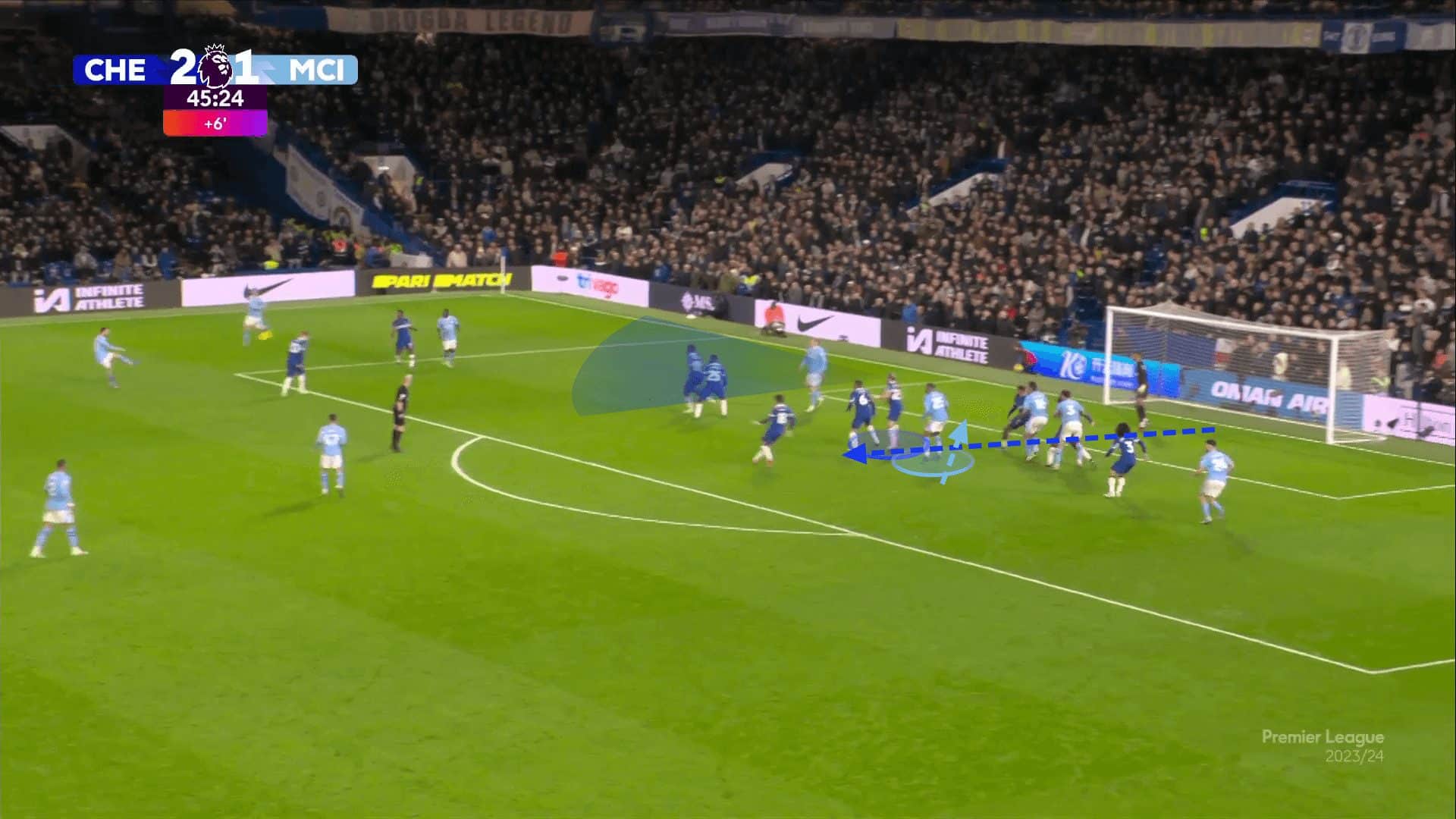
If the deepest player was a natural defender, they would be much more likely to identify the open space, cover that space and clear the cross — or, at least, disrupt Akanji from heading the ball freely.
These consistent issues in defending set-pieces cause Chelsea issues game to game, where close games can be decided by how well they can defend a corner kick.
9) Goal Kick Leads to a Goal, BRENTFORD vs Manchester City – Attacking Goal Kick
This next set play is much more unique and makes the most of the different rules of not being offside from a goal kick. From the goal kick, the front two of Brentford, Toney, and Maupay, both stand in offside positions, out of the defender’s eyesight. The deep positions of the defensive unit of Brentford lure the Man City side to think the goal kick will be played short and push further up the pitch.
When the kick is taken long, Toney is able to arrive in front of the defender who is about to challenge for the ball. Arriving from the blindside surprises the defender, who usually doesn’t have to worry about a player coming from an offside position. This late movement makes Toney’s screen more likely to succeed, allowing the ball to pass through the defensive line, where Maupay is waiting to receive the ball. Yet again, with Maupay hanging around offside, defenders naturally are happy to let him stay behind them, even though, in this exception, he is onside.
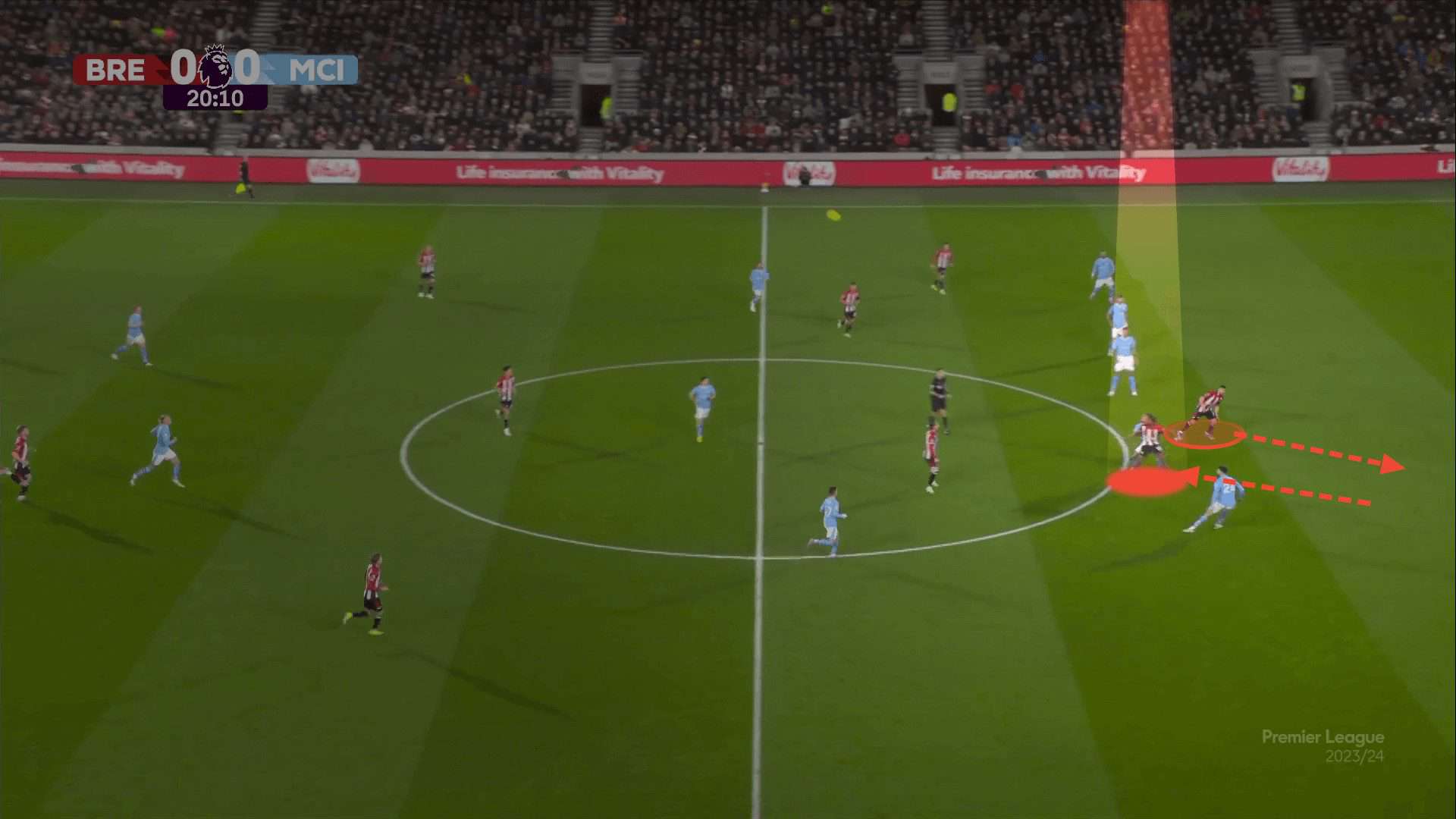
8) Early Runs Influencing the Offside Line, Luton vs NOTTINGHAM FOREST – Attacking Free Kick
Free kicks have recently been influenced by players standing in offside positions, where they can create instant separation or block defenders from getting back in their supposed position. Teams have also used fake runs from free-kick takers to bait defensive players to drop deep early. However, there is an issue of players who start in offside positions and actively attempt to attack the ball, where they are directly influencing the game and being called as offside.
In an effort to make defensive lines drop deep as efficiently as possible and not directly impact play from an offside position, Forest sacrifice one player who makes the attacking run before the kick is taken. This baits the defender into following the runner into the box while the rest of the team is still holding their position further up. He makes the move on the outside of the defensive unit, giving the central players the opportunity to gain those advantages while being in higher-valued goal-scoring situations.
As seen in the example below, the movements allow the rest of the attacking unit to move goalside of their markers while still being onside due to the one defender who is deeper in his box.
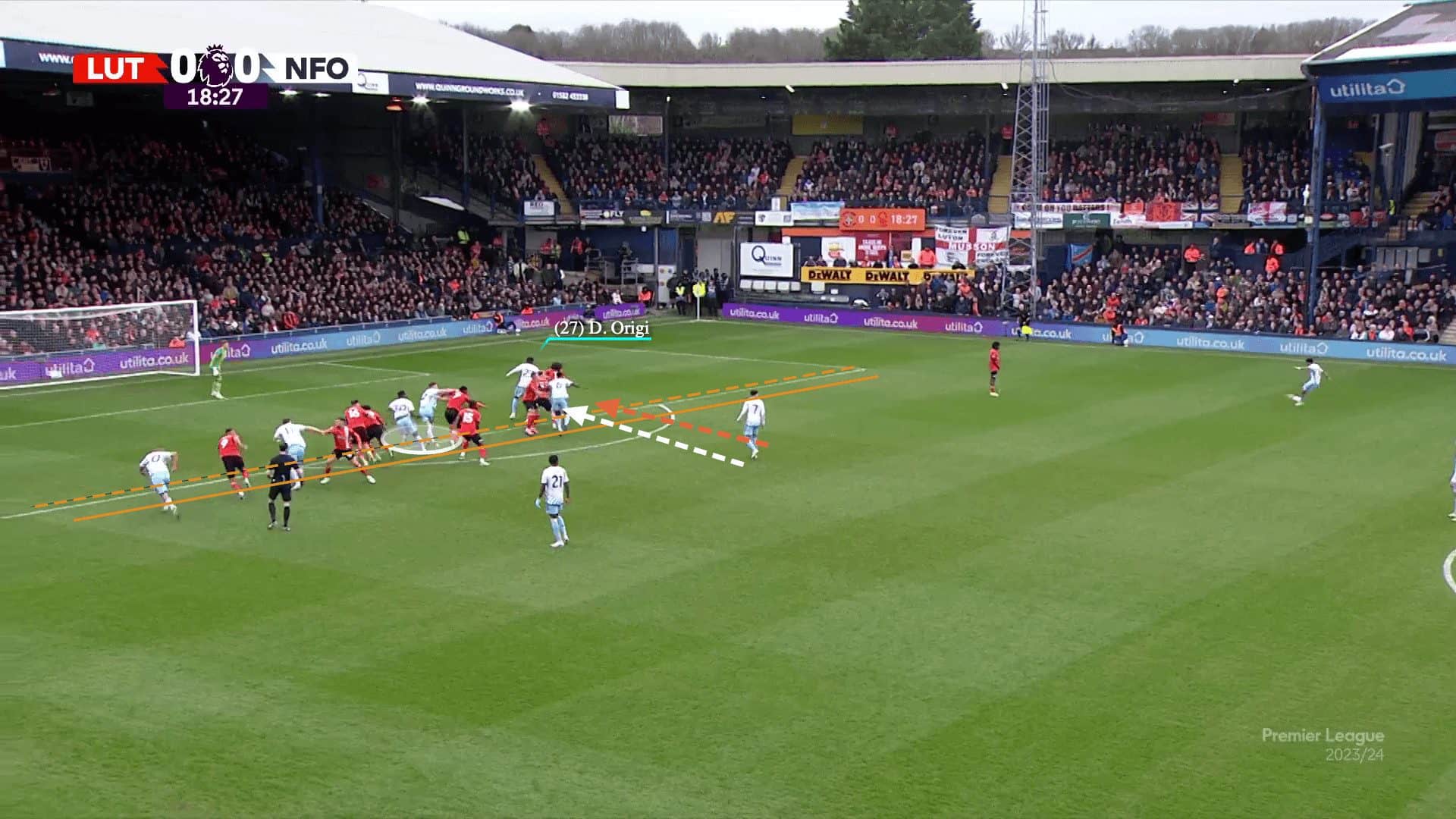
7) Screens Creating Targeted Space, Manchester United vs WEST HAM UNITED – Attacking Corner Kick
West Ham have had a high number of set-piece goals this season due to the dead-ball precision of Ward-Prowse and the commanding aerial ability of their players. Usually, they resort to inswinging corners, with the attacking unit crowding the goalkeeper, and have the certainty that the cross will drop right on him. All that is needed is one slight touch to redirect the ball into the back of the net when they are within a couple of yards from the goal.
However, when outswingers are used, new solutions are required. One method they have used to create additional space has been through the introduction of screens. In the example below, we can see two attackers quickly moving in front of the zonal defenders, setting screens to create space in the highlighted area.
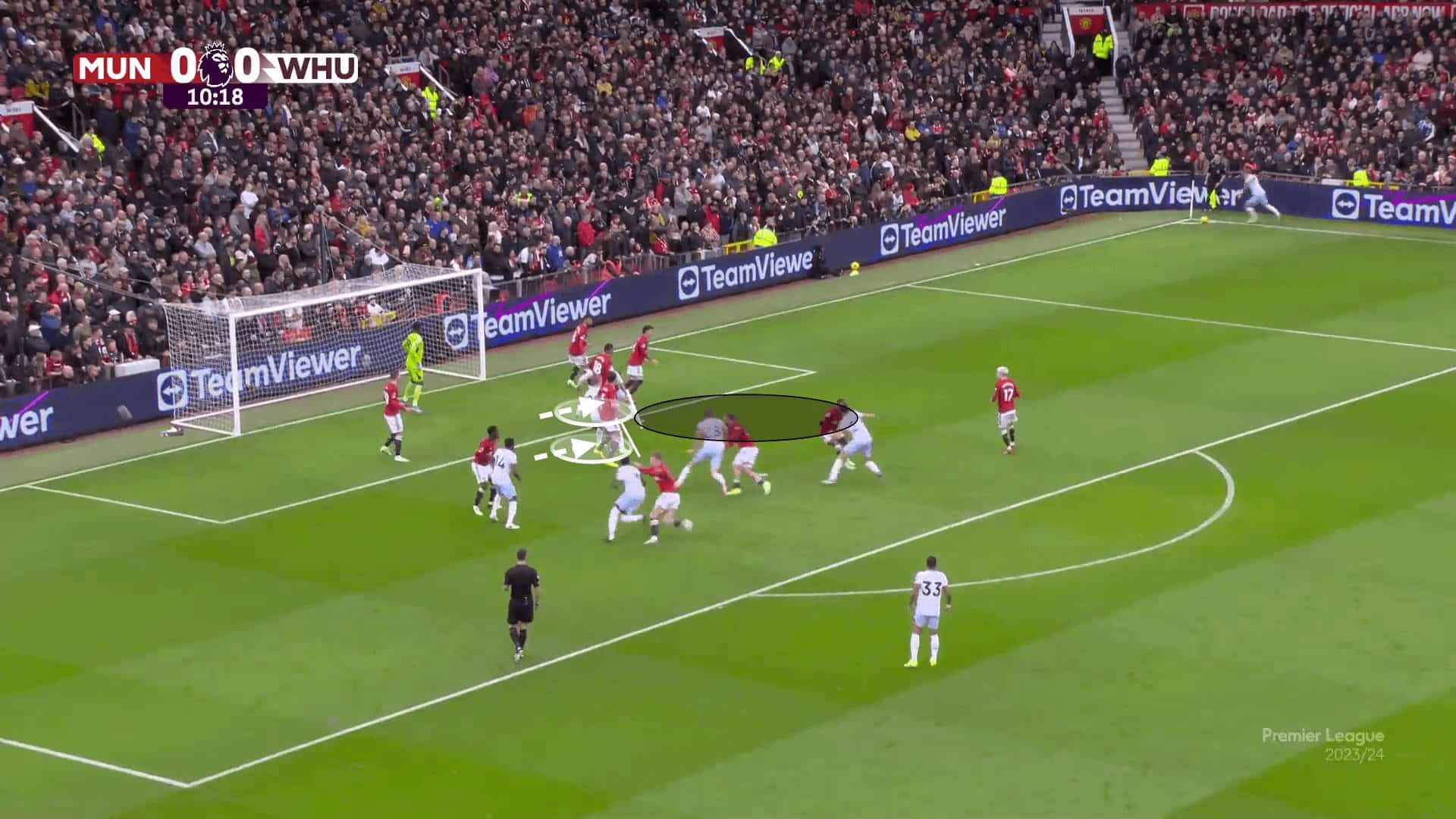
While the thought process is positive and well executed, they forget to work on a crucial part of a successful corner kick, creating separation for the attacker. Each of the attackers who attempt to attack the ball are closely marked, meaning that when they attempt to attack the ball, they cannot do so cleanly without anyone disrupting them. Even though they are able to deliver the ball into a good area that is made open, they are unable to successfully clear the path for a player to arrive at the ball, making this sort of routine much less effective than it could be.
6) Attempting to Disrupt Routines – Arsenal – Defending Corner Kicks
Arsenal have massively improved in both boxes in terms of set plays this season. Looking purely at the defensive aspect of their set pieces, it’s clear that certain players have been given extremely specific instructions on how to stop teams from scoring from corners.
Martin Odegaard has been used as a disruptor. His role is usually to prevent attackers from reaching the near side of the six-yard box, stopping teams from making shots at the near post or from flicking the ball on to create second-contact opportunities. The image below shows just how engaged in the physical battle Odegaard is. He has no interest in actually clearing the ball, which is left to zonal markers.
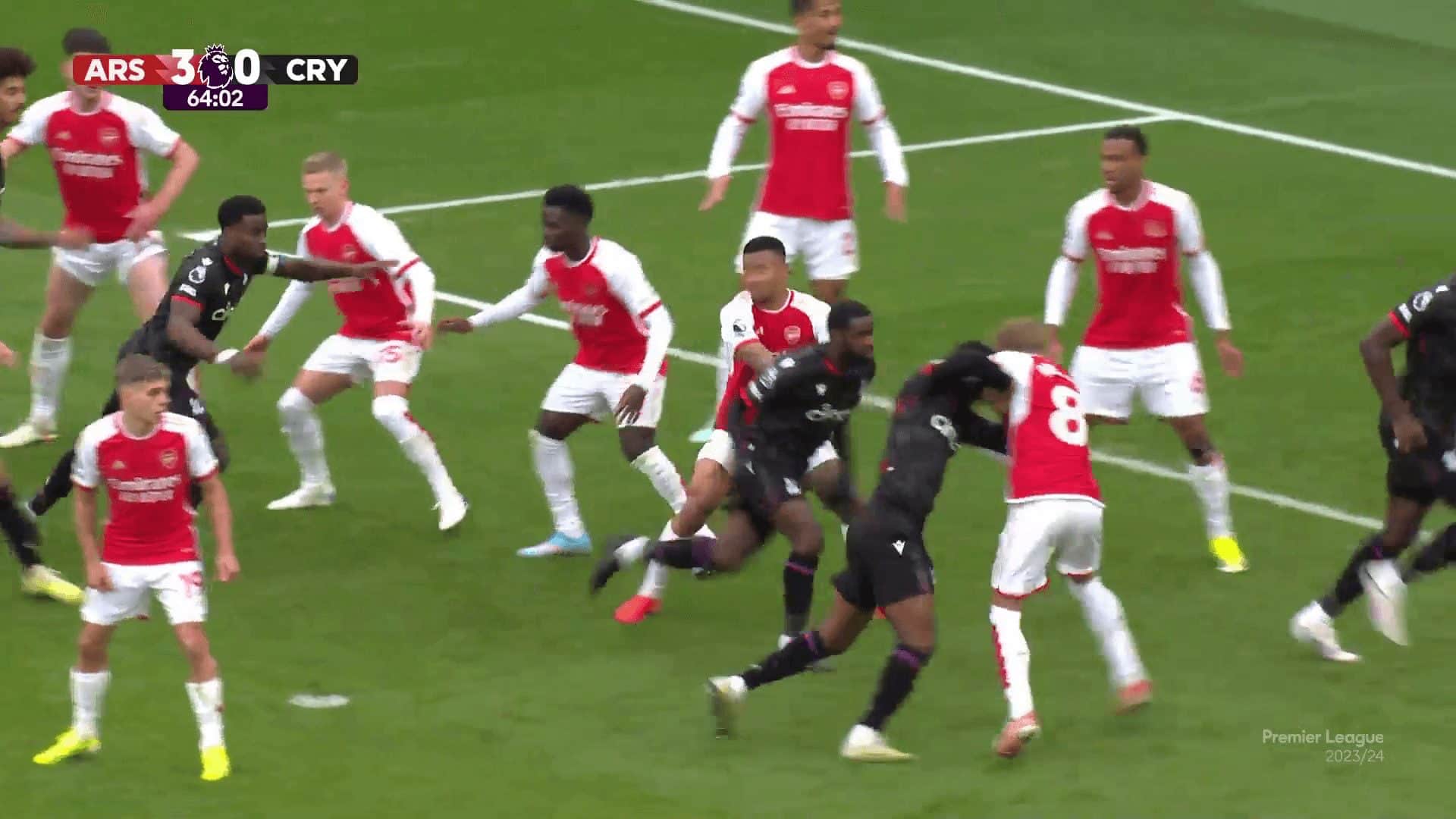
This role can be effective, as it has been on many occasions this season. Some previous examples include successful disruptions of runs against both Aston Villa and Liverpool, but it also has its flaws. As the example below shows, Odegaard is attempting to stand in the attacker’s path, preventing him from reaching the six-yard box. However, the cross isn’t aimed towards the six-yard box on this occasion. It is aimed at the deeper area highlighted, which Palhinha is able to enter. Meanwhile, Odegaard is only interested in the player, meaning he has no clue where the ball is, and even though it goes just past his head and could have been cleared, it travels past him. It allows Fulham to generate a high-quality chance of scoring a goal.
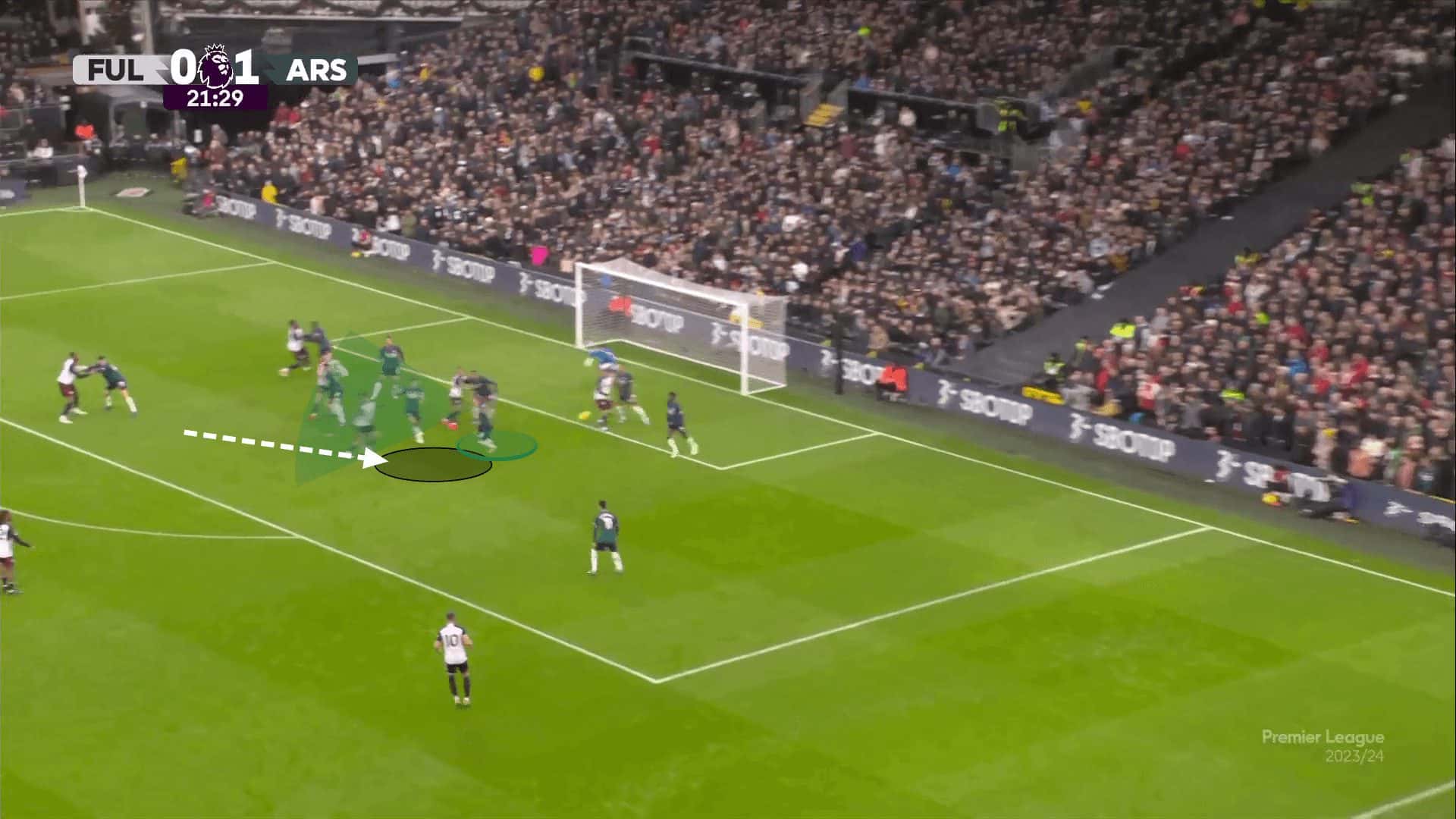
One other adaptation Arsenal have used is to plant Saliba on aerial threats. Usually, his role is to guard the far side of the six-yard box, but in the instances where the ball is expected to land elsewhere, like with outswingers where the ball would be claimed by the keeper before Saliba even got a chance to battle for it, Saliba has been able to vacate his role, to move somewhere where he is likely to be involved in the aerial battles.
For example, Liverpool’s main aim is to cross the ball far from the goal, where Van Dijk is able to use his strong heading abilities to take shots at goal from the penalty spot, where he is usually marked by smaller players, whose role is to prevent him from reaching the six-yard box. In an effort to counter this, Saliba is tasked with marking Van Dijk, which makes the aerial duel a 50/50. Having to battle for the cross, rather than easily winning it like he usually does, means that he is unable to put as much focus into the actual headed effort, which needs to be well executed considering the distance from the goal.
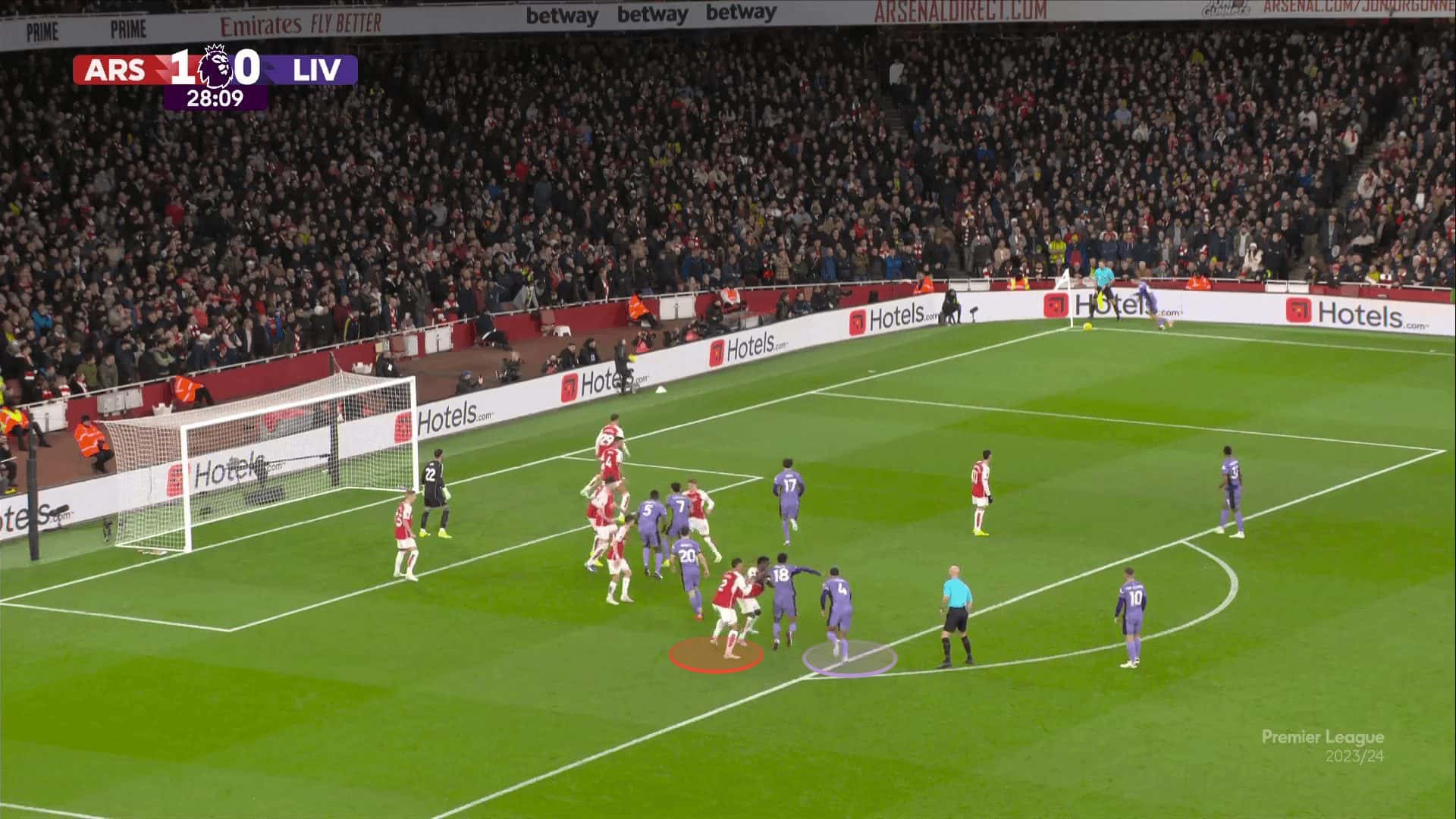
5) Deep Run Exploiting a High Line, SHEFFIELD UNITED vs Aston Villa – Attacking Free Kick
A recent article discussed the importance of deep runs being used to exploit the space behind the defensive unit from free kicks. Sheffield United expertly showed how to execute this idea with their routine against Aston Villa, which ends up being marginally offside but can be fixed with better timing of the runs.
In the defensive unit, we can see defenders ready to cover the space behind them, but it is impossible to be in a position where you are prepared to track back and see what is happening on both the left and right. As a result, the furthest player, on the outside of the defensive line, can lurk in the blind spot, where no defender can see the run. Furthermore, screens are used on the widest defender, to prevent the nearest potential defender from being able to cover the ball being played in behind.
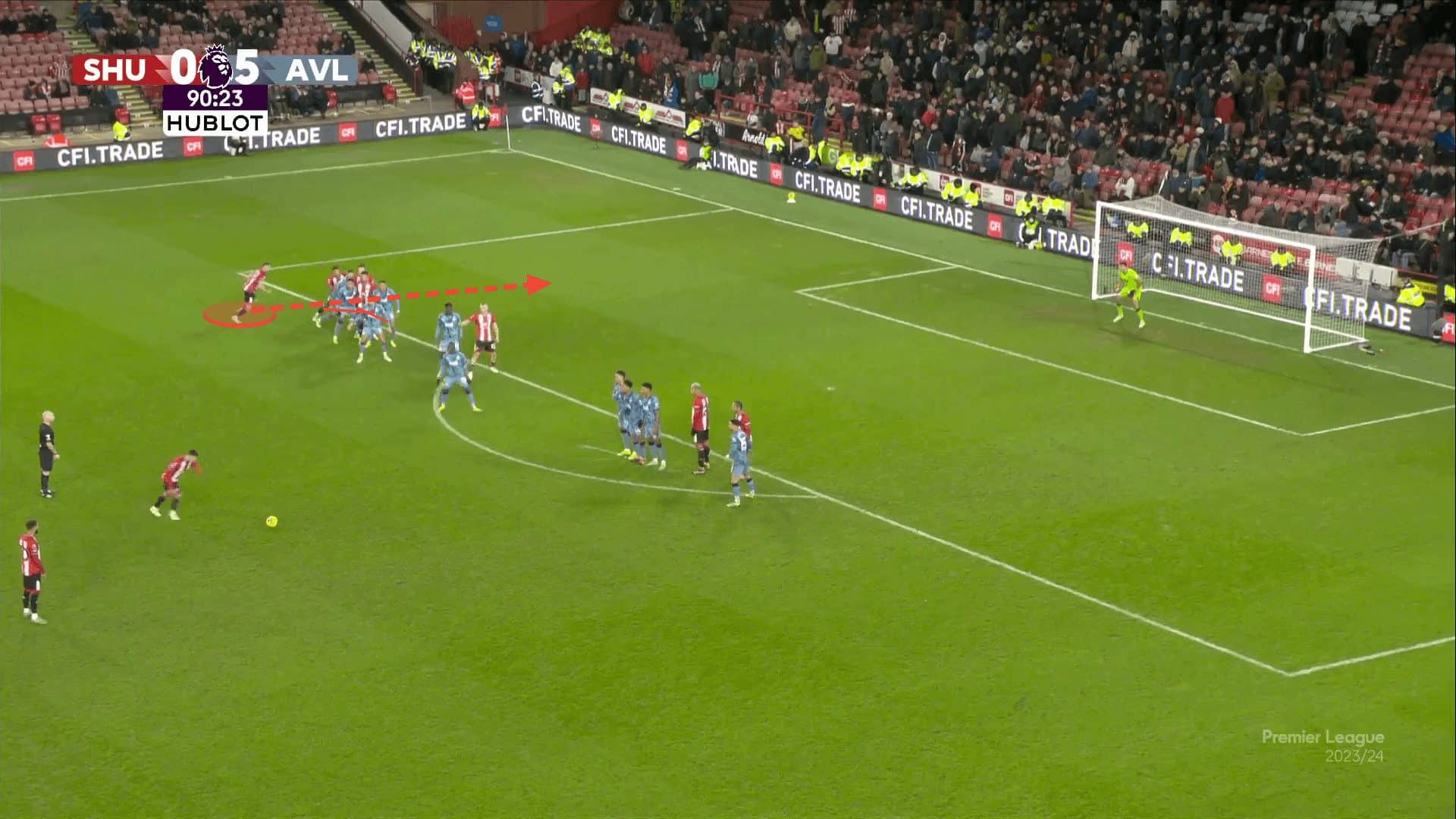
The attackers situated behind the wall can then arrive in dangerous positions inside the box. From the free kick, it’s unlikely they will receive the pass and are able to be unmarked, which gives them the opportunity to time their arrival in the box as the header is played back across goal.
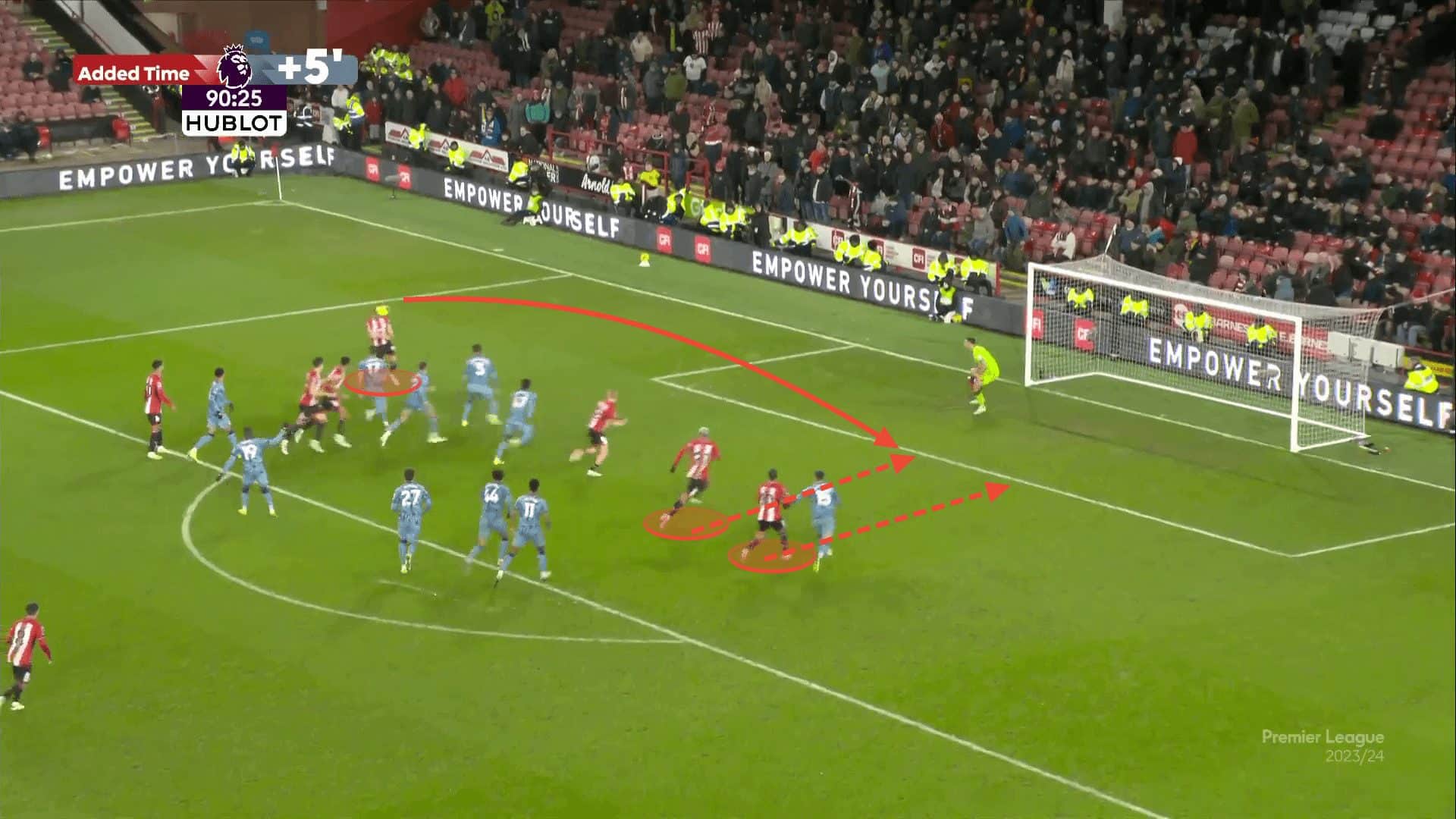
4) Using Screens to Freeze the Offside Line, Everton vs ASTON VILLA – Attacking Corner Kick
Aston Villa have used numerous uniquely creative ideas from set plays to gain an advantage over their opponents. There have been many attempts to reduce the potential of an offside from corner kicks through players receiving the ball at the by-line, where the opposition team are then unable to step out of their box and reduce the space available.
Another way in which Villa tried to force the offside line to be deeper was by pinning the deepest defender in their place to keep the offside line at the goal line. We can see in the image below how the block forces the defender to stay deep whilst everyone else attempts to step up. This creates space in the narrow channel between the goal and defensive unit, where we can see players able to receive the ball in positions which they usually are offside from.
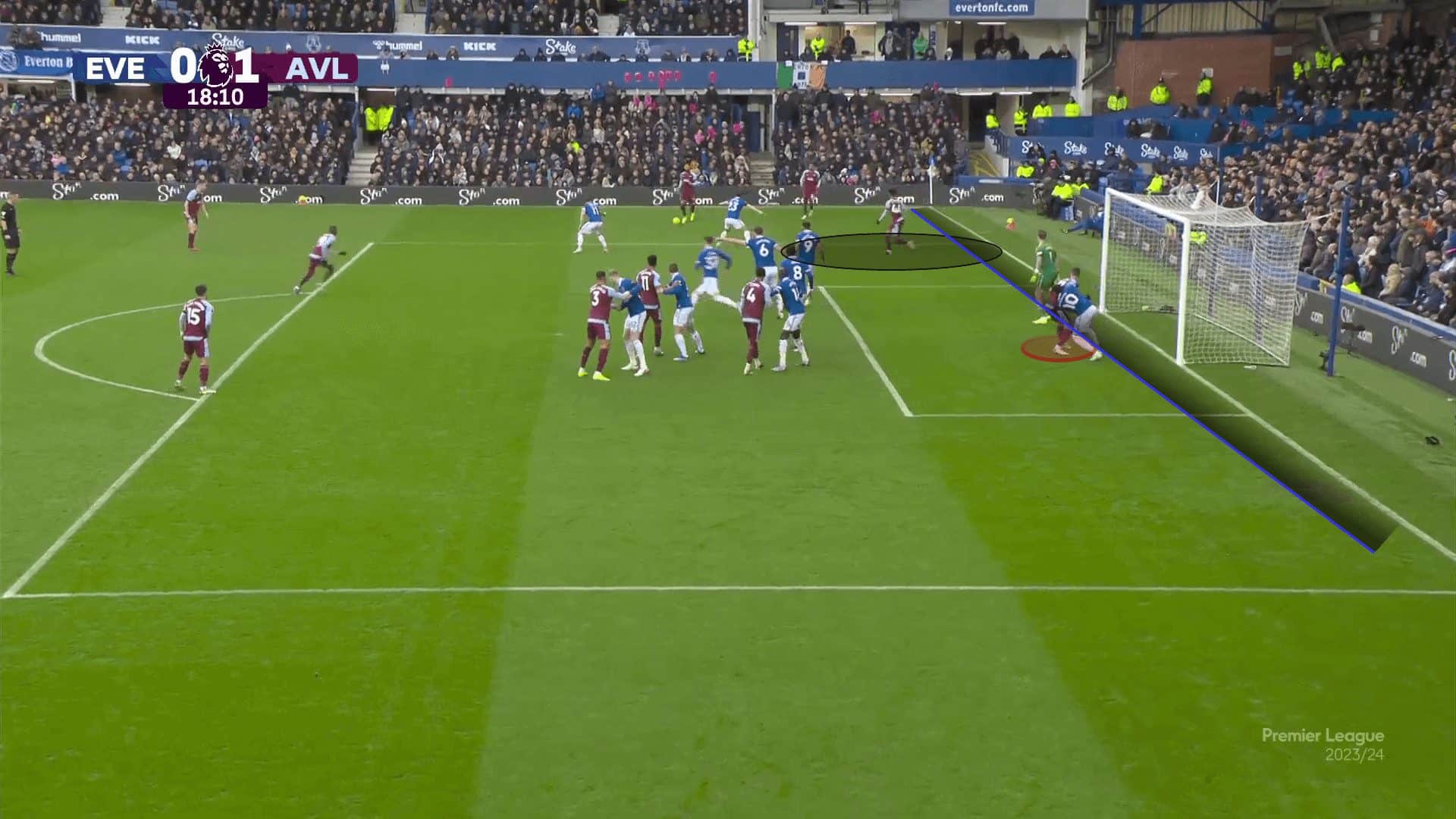
This particular routine resulted in a foul during the block, which probably deterred Villa from trying it again, but at the point in the example above, no foul has been made while the pass to a player in space is on. Of course, it can be difficult to keep defenders pinned for more than a couple of seconds, but if Villa can move the ball quickly enough in the initial couple of seconds when the deepest defender is pinned and attempting to evade the block, they can exploit the space created between the pinned defender and defensive unit which has stepped up, in future games.
3) Ghosting to the Back Post Following a Short Corner, Nottingham Forest vs NEWCASTLE – Attacking Corner Kick
Similarly to Sheffield United’s routine, being able to set screens on the widest defender in the block creates the potential to attack the space on the outside. It is quite simple to go around the defensive shape and arrive at the back post following a cross, which requires less precision than those that target gaps between defenders.
The use of a short corner baits the defensive block to step up and drags the attention to the ball. As a result, Bruno Guimaraes is able to make his run towards the space at the back post, with every defender being more concerned about the ball and not noticing his movement, which begins after the defensive block’s attention is diverted. In this particular example, the box defending of Forest is quite narrow, giving Newcastle plenty of space to attack the box, around the defenders.
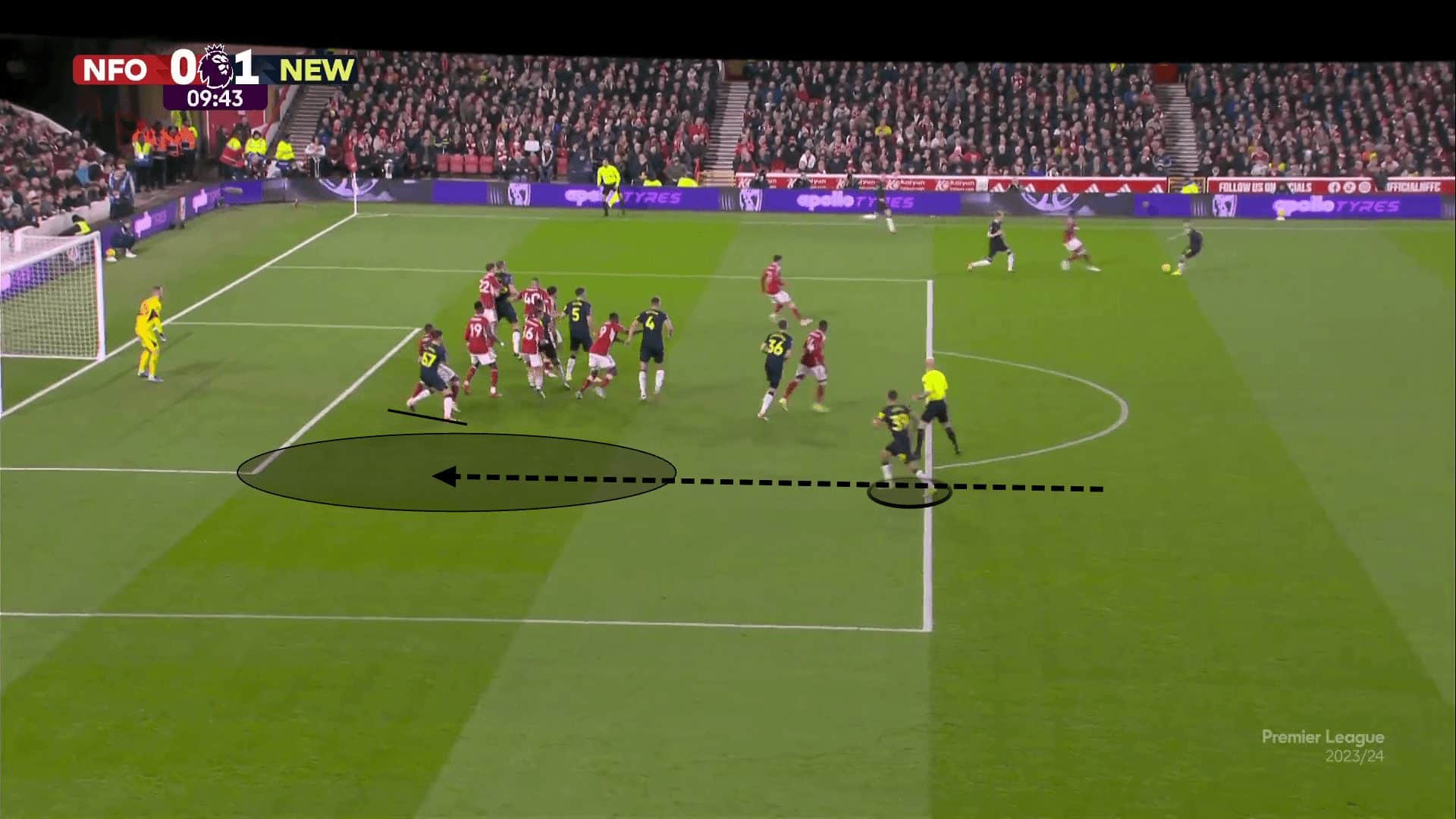
2) Attacking Space between Zonal Defenders and the Goal, Liverpool vs MANCHESTER CITY – Attacking Corner Kick
Manchester City have shown their superb ability to adapt routines, to target the spaces that opposition blocks leave open. In their fixture against Liverpool, it is clear that Liverpool use a heavy zonal presence around the six-yard line. Five zonal defenders are used, with only one protecting the passage into the six-yard box, whilst the goalkeeper also has a high starting position, intending to cut out any crosses arriving within the penalty spot.
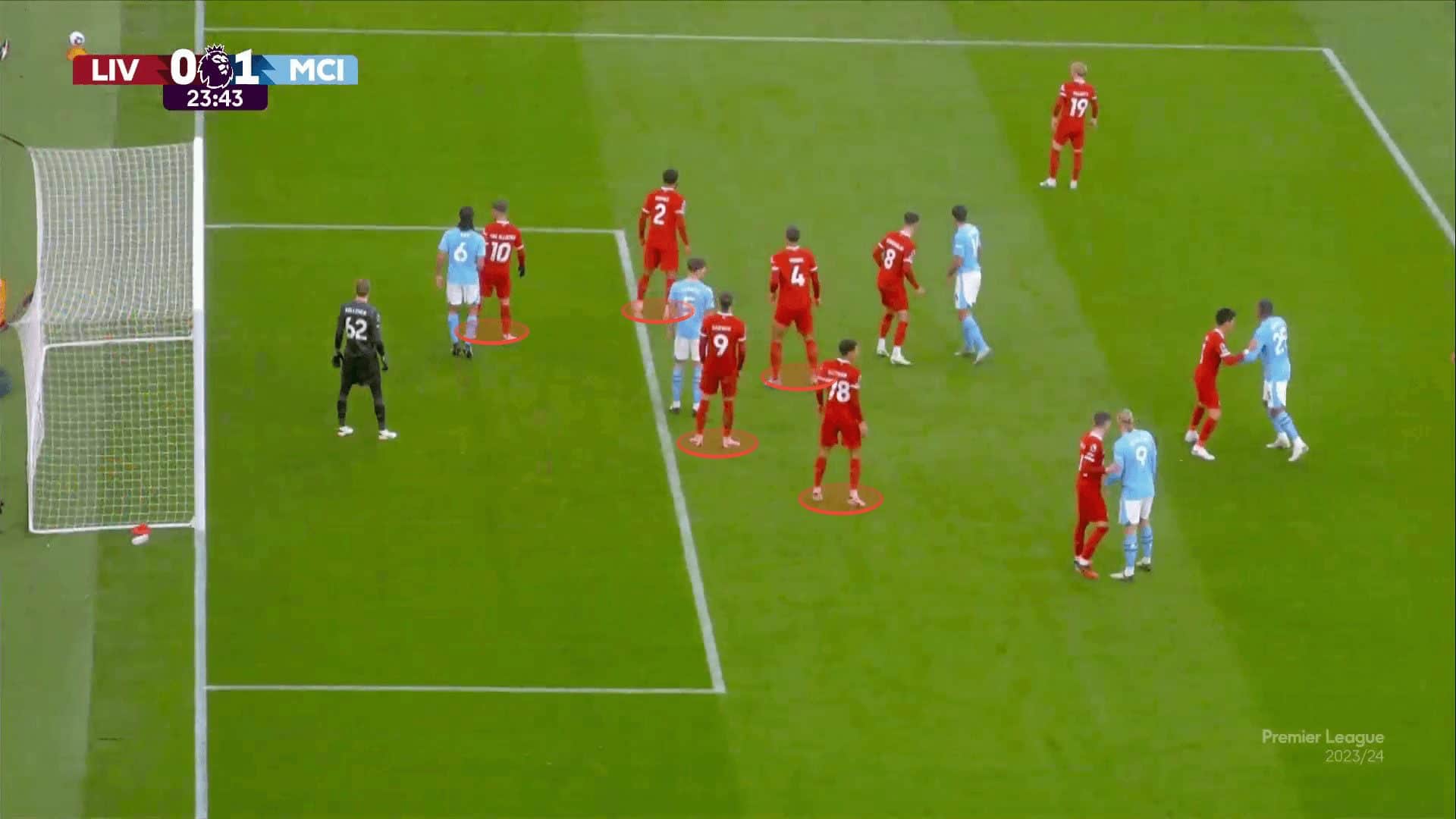
The use of an out-swinging delivery further encourages Liverpool’s defenders to step further up the pitch away from their goal. The assumption that one zonal defender and goalkeeper can protect the six-yard box is something that has allowed Liverpool to be effective at clearing deliveries arriving outside of the six-yard box by increasing the zonal presence. Still, fewer man markers have left them vulnerable to different screens and blocks.
In the example below, Ake moves goalside of the only zonal defender inside the six-yard box. His arrival from behind Mac Allister’s back gives him the element of surprise, with the Argentinian not anticipating a physical confrontation. The element of surprise gives Ake the chance to shift Mac Allister away from goal, which creates a safe passage into the near side of the six-yard box through a masterful delivery from De Bruyne. Stones is able to arrive in the space to put the ball in the back of the net, whilst none of the zonal defenders take responsibility to mark the attacker nearest to the goal. John Stones’ late movement after the kick is taken, gives Nunez almost no time to get in the correct position to stop Stones from being able to have an easy chance on goal.
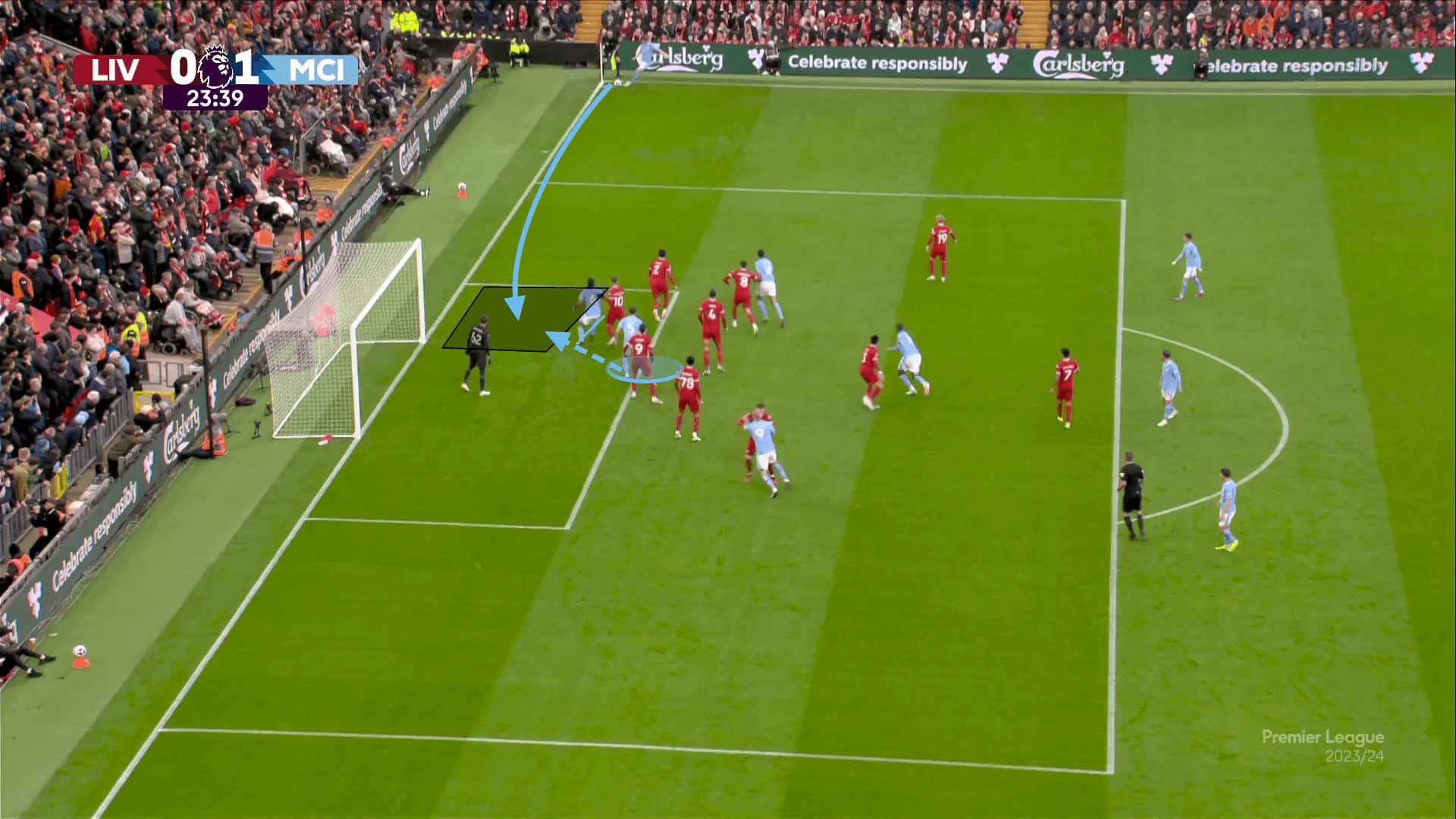
1) Volley Efforts from the Penalty Spot – FULHAM – Attacking Corner Kicks
Fulham’s method of generating volleys on goal from slightly deeper is the most interesting tactical innovation we have seen in the Premier League. Volleys are much harder to deal with than headers due to the potential power you can generate with your leg. Even though these volleys are executed further away from the goal than you’d have a header from, the power of the shot actually gives goalkeepers less time to react than they have against most headers.
The thing that separates Fulham’s routine from the majority of the other routines analysed is the fact that they have been using and scoring/creating chances from this specific method all season long. The well-planned movements and execution mean that this can be repeated over and over again, giving Fulham the opportunity to remain dangerous from corners, no matter who the opposition is.
The deeper areas of the box around the penalty spot are never marked zonally, although the zonal defenders around the six-yard line have time to step out and clear the ball. In order for the ball to easily access these areas, Fulham consistently set screens on those zonal defenders who could clear the ball. This gives Fulham the security that most corners that hit the area highlighted can freely enter without being cleared.
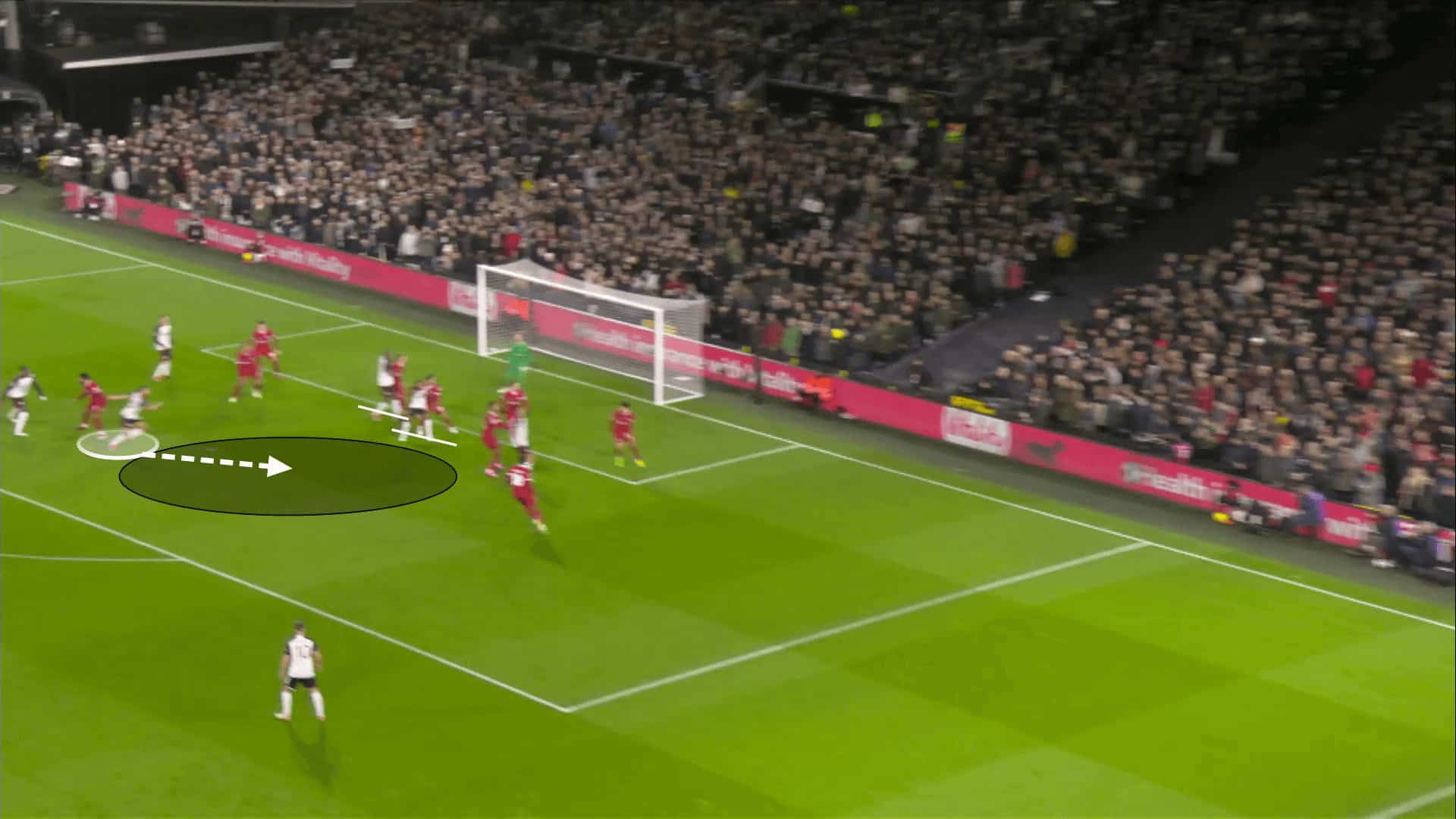
All that is left is to ensure one player can arrive in the space to generate a volley on goal. There are several ways in which this is possible. In the prior example, Fulham’s overload in the attacking unit against Liverpool’s low number of man-markers means that a player can start unmarked without any work necessary to create separation. Against big groups of man-markers, packs can be used to create heavy congestions, where one player is able to attempt to move around the cluster and arrive in space.
When the man-markers are individually marking Fulham’s attackers, like in the image below, a screen is set for the designated attacker to give him that yard of separation to arrive in the target area unmarked, of course, for this to be effective; Fulham execute the screens and runs at the last moment possible, not giving opposition sides time to react to the screens which are only set as the ball is crossed in.
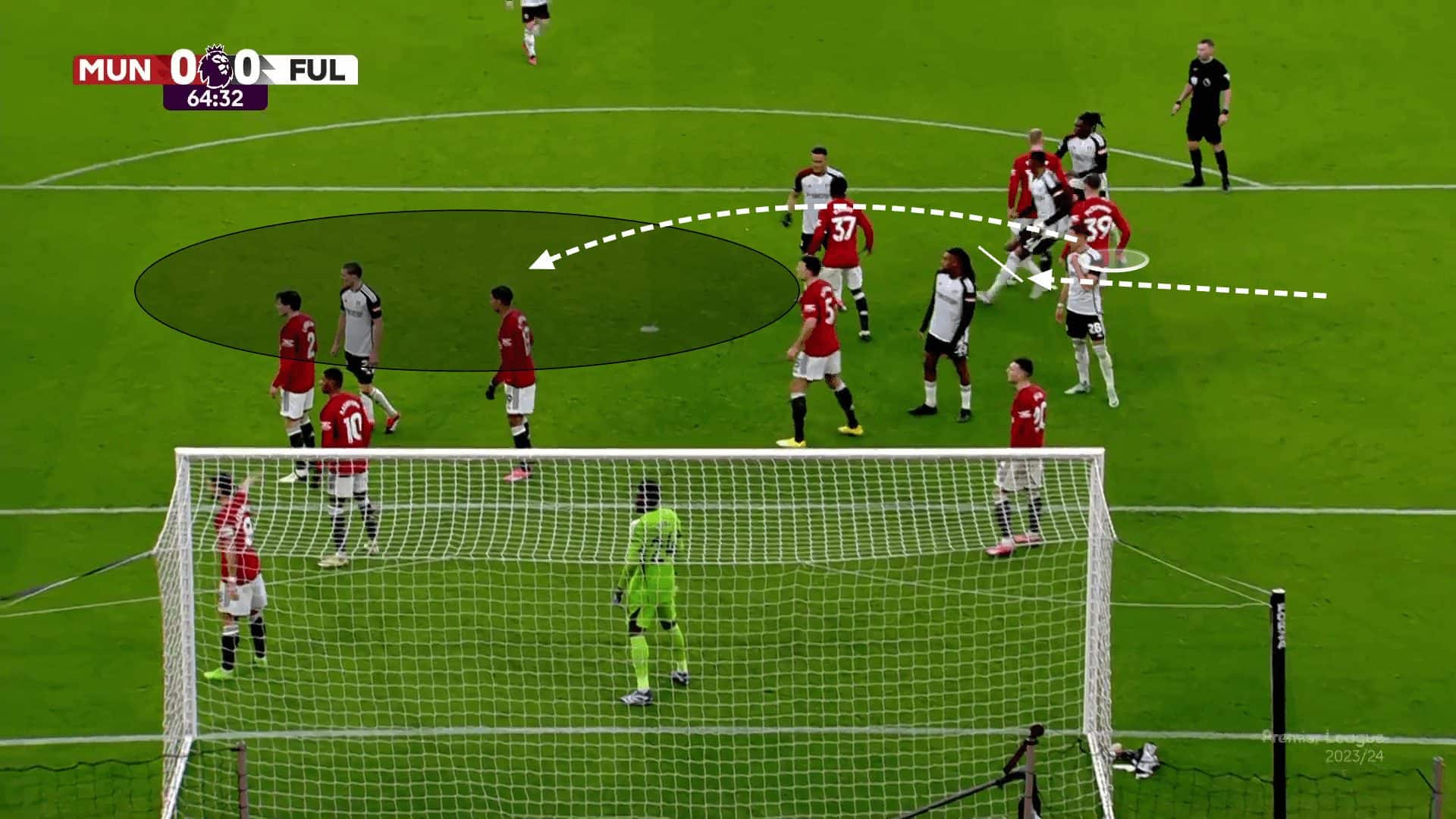
Fulham have also been able to add extra goals following second-phase opportunities of this method through Bobby Reid’s role as a six-yard line scavenger. His positioning between the target area and the goal gives him the opportunity to block the goalkeeper’s view of the shot coming in and also allows him to be close to goal, to attack rebounds or loose balls. With volleys being harder for goalkeepers to get a hold of, the number of rebounds increases when using this method, giving Reid and other Fulham players ample opportunities to receive the ball in the second phase.
Conclusion
This detailed analysis explores the ideas and benefits behind some of the most innovative set-piece tactics used in recent months in the Premier League. It’s fascinating to see the different ways teams can gain advantages, highlighting the potential for earning crucial points through set plays. This article shares proven set-piece routines that clubs worldwide could adopt.

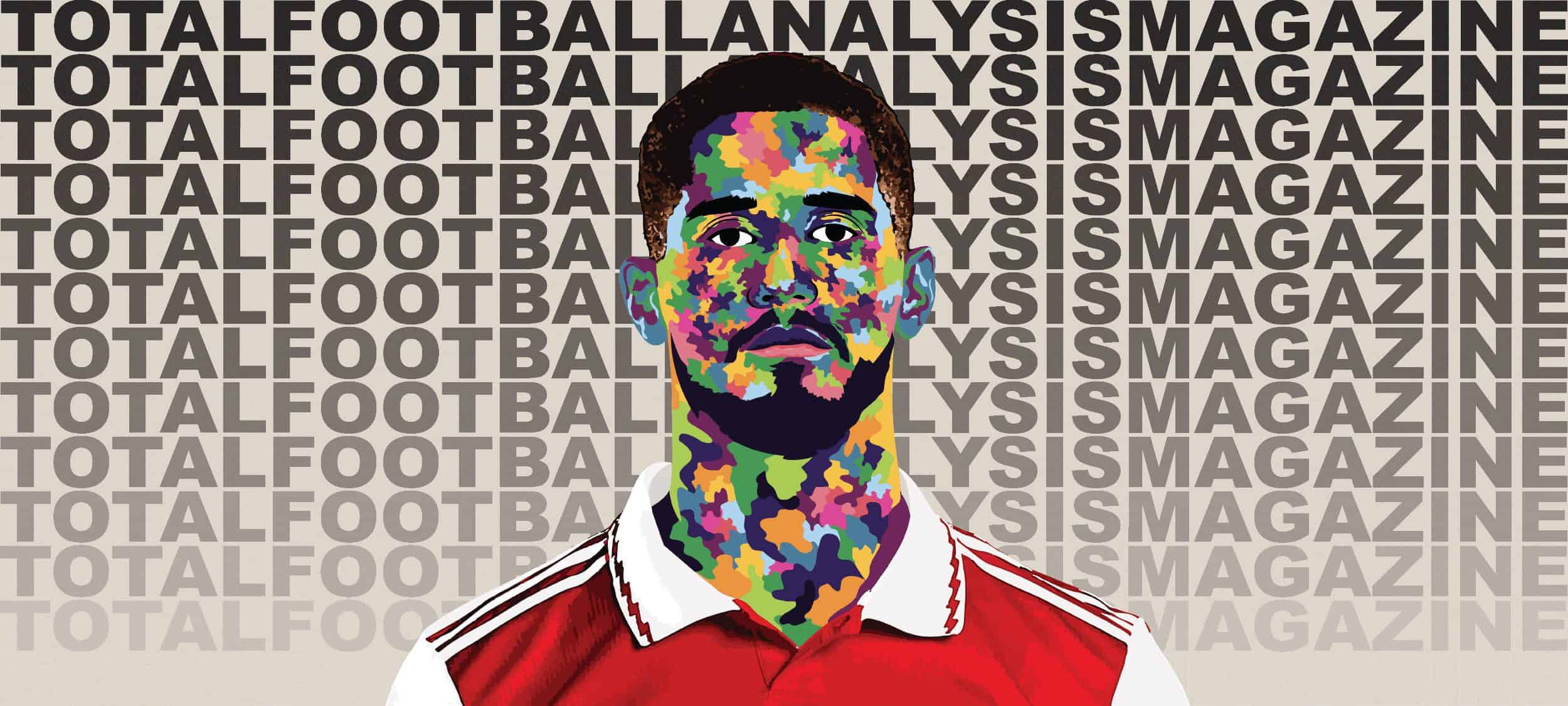




Comments